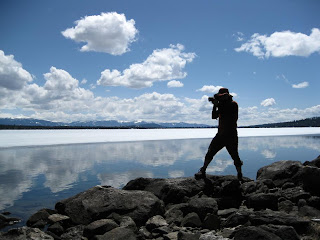“In the first place, the best information
I can get from experienced fliers is that
all parachute jumpers are more or less
crazy—-just a little bit unbalanced,
otherwise they wouldn’t be engaged in such
dangerous undertaking.”
--Evan Kelly, Regional Forester, July 1935

I’ve wanted to visit Missoula, Montana for years because it is the location of the
Smokejumpers Training Center and Museum. Why would a fat chick like me be so interested in smokejumpers? Perhaps I’m a bit “unbalanced.” After all, smokejumpers have to be in excellent physical condition and cannot be overweight. Still, I am sane enough not to jump out of a plane, let alone jump into a fire.
So, my interest in smoke jumping is a bit odd, but not if you’ve met my great uncle Calvin Hilty. He was a conscientious objector during World War II and became one of the early smokejumpers as an alternative to fighting in the war. I’ve been fascinated with smoke jumping ever since I learned of his service and this
history.As the quote above implies, the idea of putting out fires by sending in parachute jumpers was considered crazy when it was first suggested back in the 1930s. Perhaps that is why conscientious objectors were sent to do the job during World War II. Many Americans despised conscientious objectors because they refused to fight in the war. They were treated as if they were cowards and given undesirable jobs as alternative service. Like many conscientious objectors, Uncle Calvin wanted to prove that he was not a coward. Becoming a smokejumper was a great way to do it.

Smokejumpers parachute into forests to stop fires. They clear area around fires so that the fires will not spread. The smokejumpers then hike to the nearest road, carrying all their equipment—often over 100 lbs. including chainsaws, food, and tents. Their hikes can be anywhere from 15 to 30 miles. I can hardly comprehend this; I start complaining if I have to hike 2 miles carrying a 30 lb. pack.

Before World War II, smoke jumping might have been an undesirable job. Today, it is much in demand. Only the very best are accepted into the training program. Of those, 20% to 35% don’t finish. Interestingly, approximately 10% of smokejumpers are women.
I’m not sure exactly what smoke jumping was like in the 1940s when Uncle Calvin was jumping, but it must have been much more difficult than it is today. The Missoula Center has done a lot of research to develop better systems. Still, the airplanes used today are old World War II planes. Unfortunately, none were on the tarmac while I was there.

 Now that we have hit the north, here they are again. Only, they are not selling tamales, cupcakes, or BBQ. Instead, these huts sell coffee, and they appear on nearly every street corner. I haven’t seen any Airstream Espresso-mobiles, yet. But here I think it would be quite appropriate.
Now that we have hit the north, here they are again. Only, they are not selling tamales, cupcakes, or BBQ. Instead, these huts sell coffee, and they appear on nearly every street corner. I haven’t seen any Airstream Espresso-mobiles, yet. But here I think it would be quite appropriate.






































